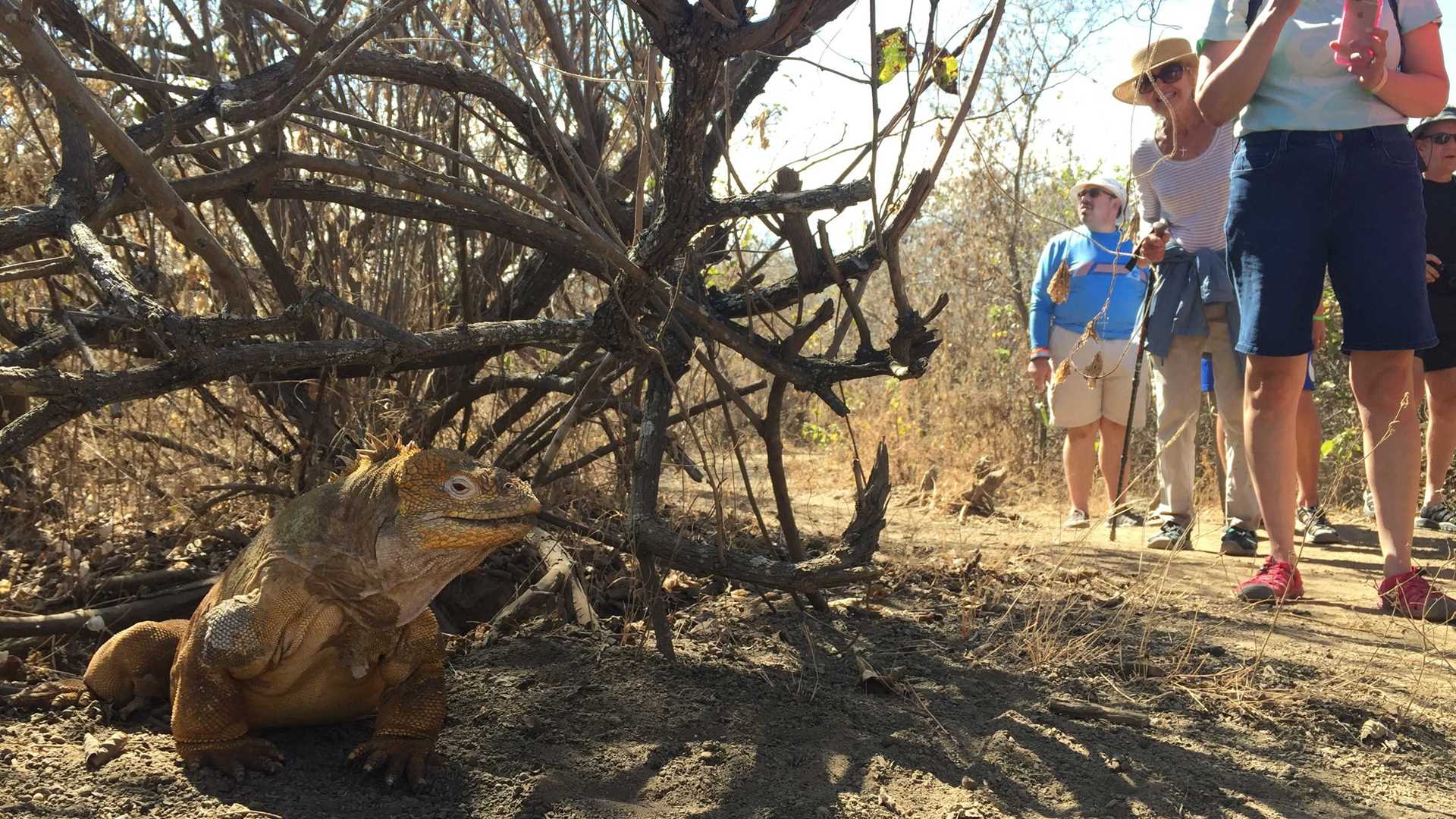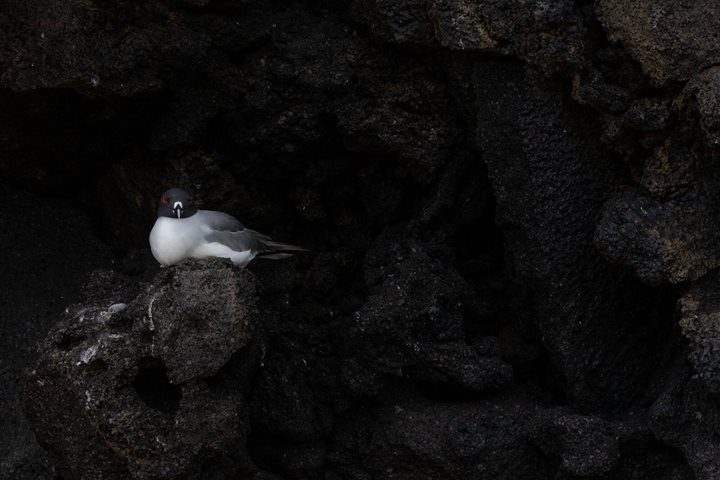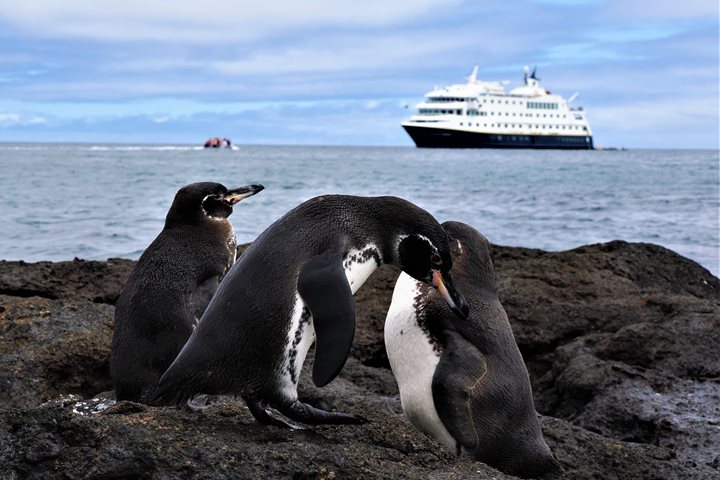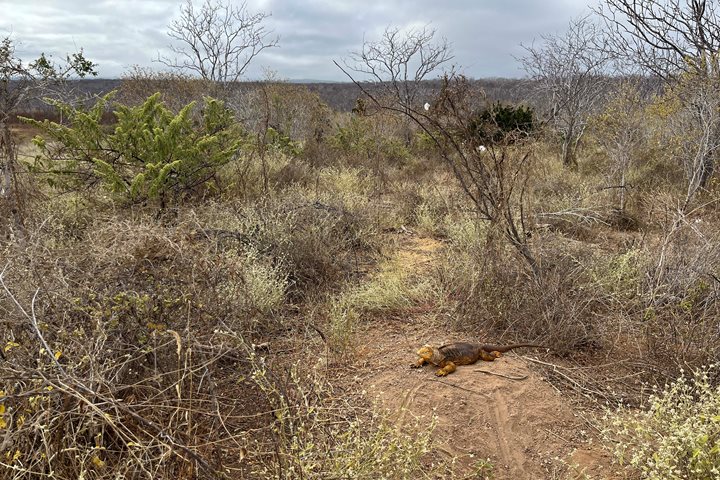Today we visited the largest island of the Galapagos Archipelago covering 58% of the Galapagos Islands total land mass, Isabela Island. In the morning we visited Urbina Bay where we enjoyed walking along male yellow iguanas and contemplating 6km upwelling terrain that occurred in 1954 when 5m of sea floor got uplifted. After a warm walk we got cool down with an open water swim from Urbina Bay beach to the ship. The rest of the day we had multiple activity options such as kayaking with sea lions, paddle boarding while we spotted sharks and snorkeling with fast swimming penguins and cormorants, yes you read that right, Galapagos swimming flightless cormorants. During a zodiac ride, Global Explorers collected plankton that we observed in the microscope and while aboard worked creating a new species of Galapagos fish using their creativity and all the knowledge they have acquired these days about fish. In the afternoon we hiked up to Tagus Cove to watch the sunset on top of Darwin Lake.
- Daily Expedition Reports
- 22 Aug 2017
Isabela Island, 8/22/2017, National Geographic Endeavour II
- Aboard the National Geographic Endeavour II
- Galápagos
Africa Berdonces, Naturalist
Africa grew up in the Galápagos Islands where she spent her childhood exploring with her family, surrounded by exquisite nature. She took her first scuba diving lesson with her father off the coast of Sombrero Chino Island when she was just 12 years ...
Read MoreShare Report
Galápagos Aboard National Geographic Endeavour II
VIEW ITINERARYRelated Reports
10/6/2022
Read
National Geographic Endeavour II
Bartolome Island & Sombrero Chino
On National Geographic Endeavour II today, we explored Bartolome, home of a small colony of Galapagos penguins. Bartolome is one of the youngest islands, and it is located next to Santiago Island in the central part of the archipelago. After an amazing sunrise, we went ashore for a walk, and we were transported back to a time when the land was newly formed. We began our day by hiking to the top of a tuff cone known as the islet of Bartolome, named after the First Officer of The Beagle . Walking on this young island allowed us to understand the formation and volcanism of the Galapagos Islands. The rocks are a great way to understand the area and its geology. We spotted a few lava lizards and painted locusts, some of the very few animals on this island. As we reached the top, we had a great view. Our guests enjoyed the magnificence of Pinnacle Rock. After we visited one of the most iconic geological formations of the Galapagos, our breakfast was enhanced by dramatic views of the impressive volcanic landscape. We visited the beach near Pinnacle Rock, where we enjoyed how the sun made the sand sparkle due to a concentration of silica. Later, we went snorkeling along the channel between Santiago and Bartolome Islands. Many of our guests spotted whitetip reef sharks and very colorful parrotfish. The landscape was beautiful with lots of sea stars. We enjoyed the chance to be surrounded by Galapagos penguins and feel accepted as part of this environment. After a delicious Mexican lunch, we had lectures on the photography of reptiles and Darwin. Afterwards, we went to Chinese Hat Islet to snorkel from the Zodiacs. The area is home to a small colony of Galapagos penguins. In a sandy-bottomed, sheltered channel, our guests enjoyed swimming with whitetip reef sharks, rays, and many fish. It was a nice and sunny afternoon. After snorkeling, we had the chance to explore the unique, small volcano that formed an island in front of Santiago on a sunset Zodiac ride. After a spectacular day full of activities in the field, we returned on board. Every day in the Galapagos is an opportunity to reconnect with the beauty of nature through unbelievable encounters!
10/5/2022
Read
National Geographic Endeavour II
Cerro Dragón, Santa Cruz Island
Today, National Geographic Endeavour II visited Cerro Dragon, located on the north part of Santa Cruz Island. We found one of the largest colonies of land iguanas. During our hike, we spotted the iguanas all around the trail. Some basked on the vegetation, and others were active. We saw the zigzag head movement they use to protect their territory and impress females. An Ecuadorian buffet lunch was set up in the dining room. We started with the traditional ceviche and ended with tres leches for dessert! We enjoyed snorkeling and Zodiac rides. We observed wildlife all over the place, including spotted eagle rays, sharks, blue-footed boobies, great blue herons, marine iguanas, and hundreds of other animals. They all reminded us why the Galapagos is so special.







